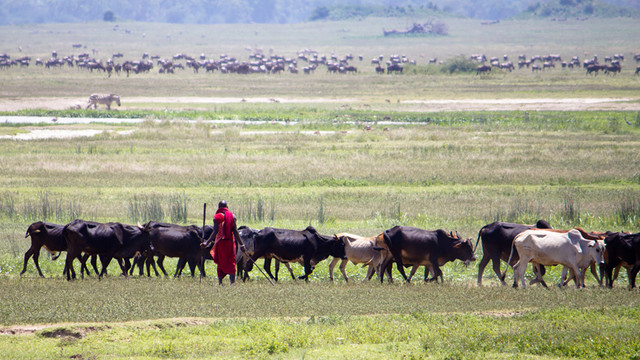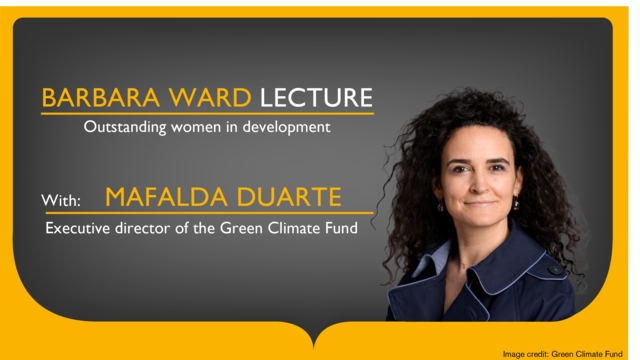The SDGs must carry us beyond Paris to 2030
The Sustainable Development Goals, to be agreed in New York later this month, are a key step on the road to a climate agreement in Paris in December, but must set the agenda for resilient low carbon development beyond Paris to 2030.


Kenya: Farmers visit a crop trial site to select the best sorghum varieties for climate resilience. Most climate change adaptation is done day-to-day by farmers, pastoralists, fishers and the urban poor. (Photo: S. Kilungo, CCAFS, Creative Commons via Flickr)
On 25 and 26 September, world leaders will be in New York for the United Nations General Assembly, when the 17 Sustainable Development Goals (SDGs) will be agreed.
The headline act for the first day, Pope Francis, guarantees a high profile. These "global goals" are the next steps in this key year for development on the road to Paris and the climate summit, but they set a direction that must go beyond Paris, challenging us to address how we achieve resilient low carbon, sustainable development in the next 15 years.
Paris is of course crucial. The 21st Conference of the Parties of the United Nations Framework Convention on Climate Change (COP21) addresses our greatest global challenge. Without tackling climate change effectively, most of the SDG agenda will not be achievable, especially in the world's Least Developed Countries (LDCs).
For the LDCs, the Paris process brings the hope of enhancing the current climate regime through a legally-binding global agreement (though this is not yet certain).
As part of the process, countries have been submitting their Intended Nationally Determined Contributions (INDCs) detailing adaptation and mitigation plans. This has seen an important shift with LDCs committing to take action alongside rich nations (some of whose pledges are far too weak).
A time for collective action
The focus on climate action also highlights why the SDGs look so different to the Millennium Development Goals (MDGs). The SDGs reflect an understanding that development action must be about solving global problems – such as climate change – that require collective action from all countries.
Principles of universality (all people everywhere) and indivisibility (you can't pick and choose) are familiar in global human rights law. They are now firmly established in the development space.
Once it was clear that the new goals would be universal, it was inevitable that they would be broader in scope than the MDGs. The rationale for the MDGs was about making aid more focused and producing more impact. But with a global, universal agenda, this focus has changed.
And the nature of aid has also changed. Flows of private finance have increased; there are new international public finance actors who do not see their efforts as official development assistance (ODA); there has been progress on tax revenues in some developing countries, with new forms of investment possible (PDF); and there is a growing realisation that global tax rules may be more important in the long run than aid.
The SDGs can play an important part in how we understand development against that backdrop. They offer a vision with compelling new elements – the reduction of inequality, conserving ocean resources, better managing terrestrial ecosystems and providing safe and resilient urban environments. There are gaps in this aspirational agenda – including an absence of focus on accountability – but at least 'democracy' is (at last) mentioned in the final version of the outcome document.
Questions of implementation
The biggest question hanging over the SDGs is that of implementation. The agenda is broad, and there is a risk of countries with weak capacity finding both data and policy implications unrealistic and overwhelming. Some targets are formulated in a way that will be difficult to get a firm grip on. And the scale of achievement implied (from eradicating poverty to universal healthcare) is prodigious.
What does this mean for IIED?
In terms of what this means for us at IIED – at this point on the road through Paris and beyond, I would pick out three priorities:
- On the SDGs we will be working with partners to provide analysis and practical support on policy and action focusing on 'new agenda goals' where our knowledge and partner networks are strong. See, for example, Essam Yassin Mohammed's blog on sustainable oceans and fisheries, and David Satterthwaite's thoughts on the SDGs and 'a new urban agenda'.
- In the run-up to Paris and beyond we will be focusing on the issue of supporting and shaping climate finance flows to the poorest countries and the poorest people.
Is there any more depressing symptom of the malaise around international public finance post-Addis than the fact that the Least Developed Countries Fund, established 15 years ago to support the world's 48 poorest countries with their most urgent climate change adaptation needs, is empty?
We will be working with our partners (in both the negotiations and research/civil society communities) to highlight the need for change.
Providing substantial and effective support to the poorest countries matters for two reasons. Firstly, these countries suffer the worst impacts yet did the least to create the problem of human-induced climate change. And if Paris is to produce the outcome we need – a strong equitable and ambitious climate agreement with effective provisions for implementation – then meeting the claims of these countries will be an important part of reaching a deal.
Not enough finance (both development and climate-related) reaches the poorest communities within countries and this will continue to be a theme of our work. Most adaptation to climate change is done by farmers, pastoralists, fishers or the urban poor on a daily basis, so finance must enhance local control and accountability to build resilience where it is needed. We need to identify innovative ways of engaging local governments as well as finding ways of delivering resources directly to poor people’s own organisations.
- Lastly, we will be using the SDG period to assess how and to what extent climate effects hinder the achievement of the SDG outcomes.
We are moving into a phase where adaptation deficits and gaps will affect the achievement and sustainability of development gains. We need to understand how to make adaptation far-reaching and far-sighted – and how to implement and achieve low carbon development.
There is much in both the SDG framework and the prospects for Paris that is encouraging.
But in the aftermath of disappointment at the outcome to the Financing for Development Conference at Addis Ababa, there is still much work to be done.
Dr Andrew Norton (andrew.norton@iied.org) is IIED's director.


